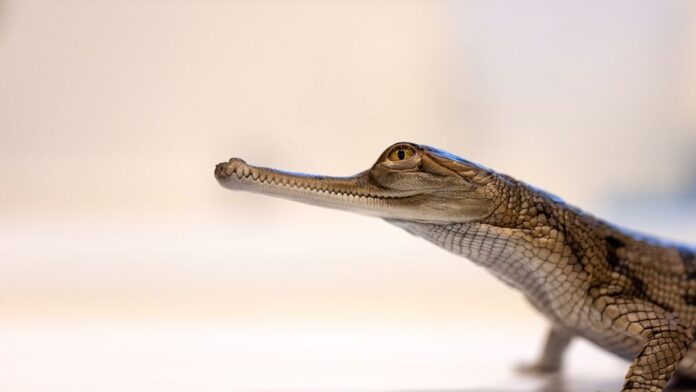Guwahati, Feb 22: In a surprise boost to conservation efforts, an endangered female Indian Gharial (Gavialis gangeticus) reptile has been spotted for the first time in 75 years in the Biswanath wildlife division of Kaziranga Tiger Reserve of Assam bringing immense cheer to nature lovers of the state.
Taking to X (formerly Twitter) Assam chief minister Himanta Biswa Sarma wrote: “Recently, due to our extensive conservation efforts, we have sighted gharials, small-clawed otters and Binturong at Greater Kaziranga for the first time in recent memory along with other exotic species. What are some of the unique species you have spotted in Assam, let me know in the comments below.”
“This endangered Indian Gharial has been spotted in the Brahmaputra after a gap of 75 years,” said Sonali Ghosh, director, Kaziranga National Park and Tiger Reserve (KNPTR).
“A 160 km long Brahmaputra survey was conducted by Biswanath Wildlife Division (under Kaziranga Tiger Reserve) and TSA Foundation India from January 16 to 25.
The survey stretched from Majuli to Koliabhomora bridge was conducted in two transects (upstream and downstream) considering the huge width of the river covering a total of 320 km shoreline,” Ghosh said.
Ghosh revealed that the team conducted habitat suitability assessments for aquatic reptiles using parameters such as river depth, channel width, water flow, vegetation cover and extent, and quality of basking and nesting (soil).
“The survey conducted by a five-member team led by Sushmita Kar and Monalisha Basistha, recorded over 900 freshwater turtles representing five species, along with one female Gharial.
Opportunistic sightings of other aquatic wildlife such as Gangetic River Dolphins and otters were also recorded to compare notes with the recent dedicated surveys on the same. Top ten habitats were characterized as a result of this survey,” she said.
Kaziranga has a recorded abundance of over 42 species of freshwater fishes and hence one of the best habitats for gharials in the long run.
The first evidence of endangered gharial has been recorded in Dibru-Saikhowa National Park (DSNP) by forest officials on October 27, 2022. The incident has undoubtedly given the reasons for wildlife lovers to be delighted.
According to the IUCN (International Union for Conservation of Nature) Red List, the reptile species, the gharial, is classified as critically endangered and is therefore included under Schedule 1 of the Wildlife Protection Act, 1972.
The species has been tagged as critically endangered since 2007 and after two years, since January 2009, a gharial reintroduction programme has been launched for saving the gharials in India.
Indian gharial is one of the largest river-dwelling crocodile species of the world that grows up to 8 metres in total length and weighs around 160 kg. Due to the massive decline in its population in the last century, the Indian gharial has been placed under the IUCN Red Data list.
In many riverine systems, it was known to be at the verge of extinction with very few breeding adults left. Adult gharials exhibit a strong association with river systems, often displaying seasonal migratory patterns.
As per survey reports, India’s largest gharial population resides in the National Chambal Sanctuary, which hosts approximately 77% of the global adult population. The remaining gharial populations in India are found in various locations, including the Katarniaghat Wildlife Sanctuary in Uttar Pradesh, the Gandak River on the Indo-Nepal border, Corbett National Park, the Son River, Mahanadi River, and Hastinapur Sanctuary.
Additionally, small populations, possibly consisting of just a few individuals, have been observed in the Ken River, Yamuna River, Brahmaputra River, Ghaghara River, and Bhagirathi Hoogly River. Historical records of Gharials from sixteen rivers in the Northeast in the 1950s reported only secondary habitat information and it was thought to be locally extinct.


